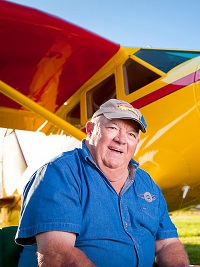A Six-Decade Commitment to the College and Profession

A 1956 graduate, Tom Dinndorf’s choice of pharmacy as a career path followed his brother Don, who graduated from the college in 1953, and his father Alex. Together, his brother and father ran Dinndorf Corner Drug in Albany, Minn. for 50 years.
“I spent my childhood at the soda fountain and sweeping the floors,” said Dinndorf.
That early exposure led to 40 years in the pharmaceutical industry, starting with service in the U.S. Army Medical Service Corps as Pharmacy Officer at Fort Carson Hospital in Colorado, and then one year at a drugstore in St. Cloud.
In 1959, Dinndorf embarked on his long career with Rowell Laboratories, which was purchased by Solvay in 1986 and required a move to Atlanta. A job with Paddock Laboratories eventually brought him back to Minnesota, and retirement followed in 2000.
“I found a home in the smaller community of the college and had a wonderful education and social experience overall”
“Coming from the small town of Albany to the University of Minnesota, I grew up at the college,” said Dinndorf. “I found a home in the smaller community of the college and had a wonderful education and social experience overall.”
Dinndorf fondly recalls Frank DiGangi as his favorite professor.
“He taught Quantitative Pharmaceutical Analysis and was a task master,” said Dinndorf. “He demanded the best and got it. If you didn’t pass his course as a junior, you were in serious trouble.”
As Associate Dean of the college, DiGangi taught and advised more than 2,000 students during his tenure. Dinndorf wasn’t alone in feeling the impact of DiGangi on their
educational journey and beyond. In DiGangi’s obituary in the Star Tribune on March 24, 2010, Professor Yusuf Abul-Hajj is quoted as stating that DiGangi “was a good administrator and the backbone of the college.”
Dinndorf fondly recalls how the curriculum at the college has evolved from his time on campus as a student to today.
“The college used to grow botanical products as so many drugs came from plants,” he said. “The University had a large greenhouse attached to Wulling Hall and we had to identify and know about botanicals. That seems so obsolete in today’s world of organic chemistry and synthetics.”
Through all of the changes, Dinndorf’s connection and contributions to the college have remained strong. From 1998 to 2000, he served as President of the Century Mortar Club and has continued to help build on its endowment.
The evolving profession and the college’s commitment to excellence continue to impress Dinndorf.
“The role of the pharmacist has changed so much and pharmacists are so highly educated right out of school today. They can advise physicians and other health care professionals about drug therapy to a greater extent than we ever dared,” he said.
Dinndorf has watched the demographics of the profession change from primarily male to a female majority entering each class—and he strongly encourages females to pursue a career in pharmacy.
“There’s such a demand, and the profession has evolved into a role as a true consultant,” said Dinndorf. “Pharmacists today know a lot more about each prescription than physicians.”
In support of the college, he and his late wife endowed the Tom and Mary Dinndorf Scholarship which continues to be awarded to this day.
“Mary was a wonderful person, and we were both committed to giving back to the college,” said Dinndorf.